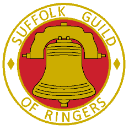Thursday 20th November 2025
Guild Training Day 2007
Report
Saturday 20th October loomed expectantly. People gathered, chewing nails, nervous and yet strangely excited. Everything was set-up and ready to go and people held their breath, wondering what was going to happen next... Thankfully, the 2007 Suffolk Guild Training Day went a lot better than the Rugby World Cup Final for this merry bunch of English folk, although after it's success we're not going to wait another four years until the next one. Hollesley may on the face of it seem a bizarre place to hold a Guild event of any kind, being a long way from anywhere. And yet people from as far afield as Long Melford, Stradishall, Glemsford and Woolpit came to partake in this novel experience.
So why Hollesley and what persuaded people to come so far for just another training day? Mainly because it wasn't just another training day. Because Hollesley has the 'listening course'.
The listening course is a new and interesting way (and possibly the best way) to get people listening to their striking. Made up of three components, people can learn to listen to their striking on any number of bells, to any method on anything from the treble to the tenor without a sound being heard outside. Conversely, inside as you wander from room to room, you are met with the sound of bells everywhere. Someone will be trying to ring Plain Bob Royal in one room, others will be listening to Surprise Sixteen in another, whilst still more attempt to put right some ringing on eight in the vestry. How can this be done?
Well it's not some kind of Doctor Who-bellringing cross-over, merely modern technology and perhaps a sign of things to come.
The first component of the course is on the face of it the most interesting. Using a simulator not disimilar to that used at the Norman Tower in Bury St Edmunds and the Abel computer program, a solitary ringer can ring anything from rounds on six to Bristol Surprise Sixteen accompanied by a computer-generated band of perfect ringers ringing at a pace set entirely by the student themselves. The idea then is to fit in with the ringing in the right place. Bereft of other actual ringers to look at, the student is forced to listen to where they place their bell in order to stay in the exact position.
A second component involves another computer, but absolutely no physical ringing. A computer-generated piece of ringing is programmed to deliberately produce bad-ringing, which the student is then challenged to make adjustments to the ringing until it is perfect.
At first glance, the third component seems fairly dull and even patronising. The student listens to various bits of ringing, intially being asked to identify how many bells are being rung but eventually testing the students listening abilities as they attempt to pick out several samples of oddstruckness and bad striking.
With all three components used together in the one course, the student comes away from the day with a real sense of having learnt something rather than just going through the motions.
In all, thirteen students were split into three groups and put through their paces but the beauty of the simulator is that even the most experienced ringers can push themselves, thus encouraging a number of interested members who were also invaluable with words of advice. Alan Moult was able to ring Plain Bob Royal without having to find nine other members, whilst Winston Girling rang Cambridge Minor at a peal speed of 2 hours 20 minutes without having to worry about the other five keeping up with him!
With the morning passing particularly quickly and no real time constraints, we all piled into the village pub, The Shepherd and Dog, where the new landlord coped admirably with the large and unexpected influx of hungry and thirsty bellringers.
Fed and watered, we returned for the afternoon session - how to ring after a pint or two in the pub! Again, everyone continued to take in and learn and despite the long journeys home to be undertaken, it was difficult to get people to leave and the day went beyond the advertised 4pm - yet it still didn't feel long enough!
My thanks and gratitude have to go to Alan McBurnie for the use of Hollesley church and for setting up the equipment needed. Also to be mentioned are Kate and Ruth Eagle for running two of the three components and for their tea duties and to Winston and Carol Girling and Alan Moult for helping out too. Indeed a big thank you to all those who took a gamble and travelled hefty distances for something they didn't really know much about - I hope it was worth your while.
Richard Munnings
